“And hit the head with a hilt ...” Battle of cuirassiers on battle canvases
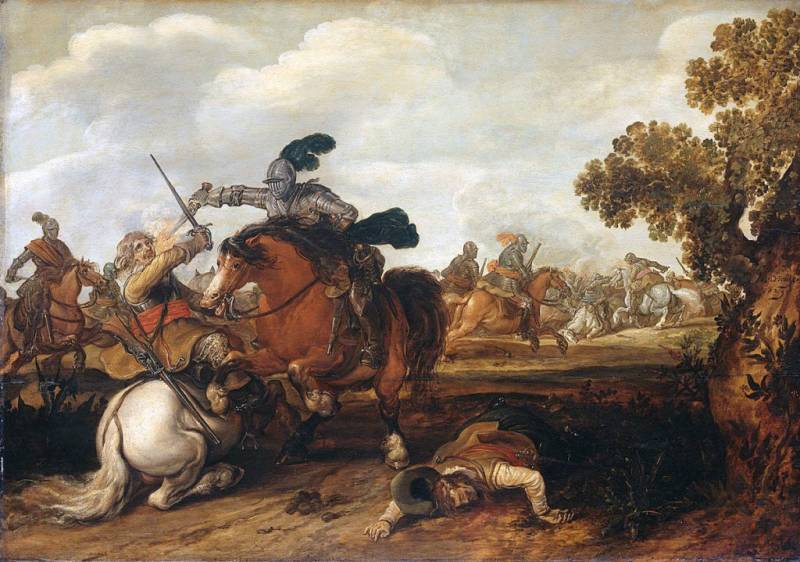
"The fight of the cuirassier with the dragoon." Painter Peter Möhlener. (Prado Museum, Madrid) It is believed that in relation to the composition of his battle canvases, he was inferior to his teacher Peter Sniers, who depicted battles in the form of whole panoramas, while Möhlener took separate episodes from them. However, for historians, his paintings are very interesting, as they give a clear idea of exactly how these very fighting episodes took place during the Thirty Years War. On this canvas we see a cuirassier chained in “three-armor armor”, point-blank firing a pistol at the head of a dragoon who was unable to use his wheeled musket and who tried to defend himself with a sword. But unsuccessfully ... In the background it is also clearly visible how other cuirassiers jump on the attack with pistols in their hands
Or look into the regiment from longing?
Is it a battle in the field,
Mud hooves famously knead!
No, peace is not salvation for me.
The spirit is decrepit and withered mustache.
On a horse! And rather to the battle!
I am essentially a cuirassier!
Yuri Bondarenko. Cuirassier
Military affairs at the turn of the eras. It is hardly worth wondering how often riders with pistols in their hands flicker on the canvases of the Flemish painters, from which they shoot at each other point-blank from various positions. After all, what was that time then? First, the Flemings took part in the war between Spain and the Netherlands, which France and England also intervened, and later Flanders joined the Thirty Years War (1618-1648), and then 11 years helped Spain fight France. As a result of all this, hostilities sometimes unfolded almost right before the artists’s eyes, and Flemish battle painting was half a century ahead of Dutch. Moreover, if the Flemings mainly wrote battles on land, the Dutch - at sea. It is interesting that even then the war was seen by Flemish artists as a tragedy, and the great Rubens somehow said something about Flanders: "Flanders was a place of military operations and a theater where tragedy is played out." But it is natural that, no matter how artists hate the horrors of war, they depicted them in different ways, introducing their vision into their visualization, their reflection of real events.
Peter Möhlener (1602-1654), for example, often painted paintings that were called: “Cavalry Attack” and in them showed different twists and turns of battles between riders-latniks of the first half of the XNUMXth century and each other. And on one of them we see a rather interesting scene of a duel between two horsemen, not armored men, but armed with wheeled pistols, one of which is trying to defend himself with a broken sword, and the other is to hit him on the head with the handle of his pistol and at the same time grabs his scarf with his hand.
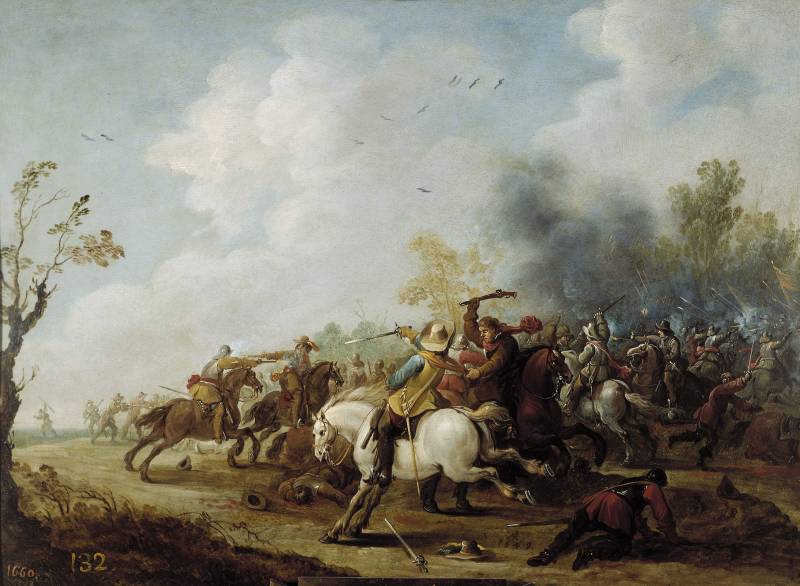
Here is the picture. It is called "Cavalry Attack", and it was written in 1649 (Prado Museum, Spain)
What is so interesting about her? And the fact that yes, indeed, cavalry pistols due to their long length and heavy grip were used by riders as a shock weapons. But the fact that they made a spherical "apple" specially for this purpose, which served as a pommel for the mace, does not receive confirmation on the paintings. That is - yes, they hit me on the head in the heat of battle with pistols. But on the same canvases it is seen that the tops of the pistol grip have a very different shape. And that this is far from always a ball. But when this top is indeed spherical in shape, as in the samples that have been preserved to this day, it turns out that inside these “balls” are usually empty, that is, light, and usually serve as pencil cases for spare flints or pieces of pyrite.
In support of this, you can also bring the picture “Attack of the cavalry”, signed by Palamedes Stevarts and dated 1631. On it we already see two wheeled pistols - one on the ground, the other in the hand of one of the combatants, but ... not one of them has a “ball” at the end of the handle. Just the handles at the end for the convenience of holding them expand, which was typical for pistols of that time, and it was this expansion that the cavalrymen used as a shock part, and so the shape of the handle could be very different. The spherical shape was by no means a principle!
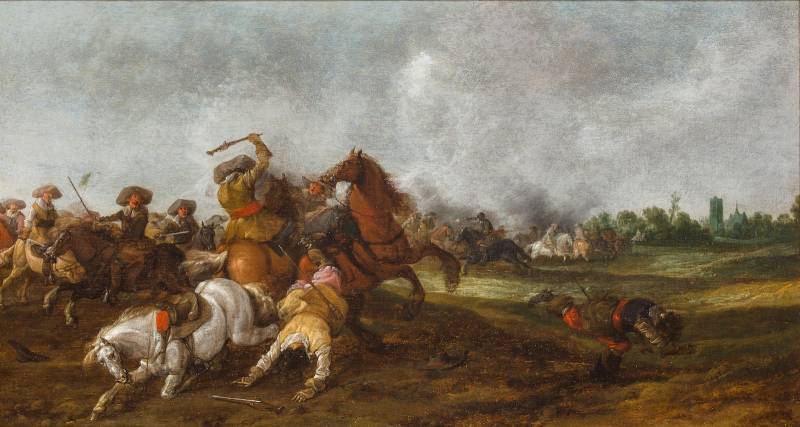
"Attack of the cavalry." Painter Palamedes Stevarts. European Painting Auction, 2013 London-New York
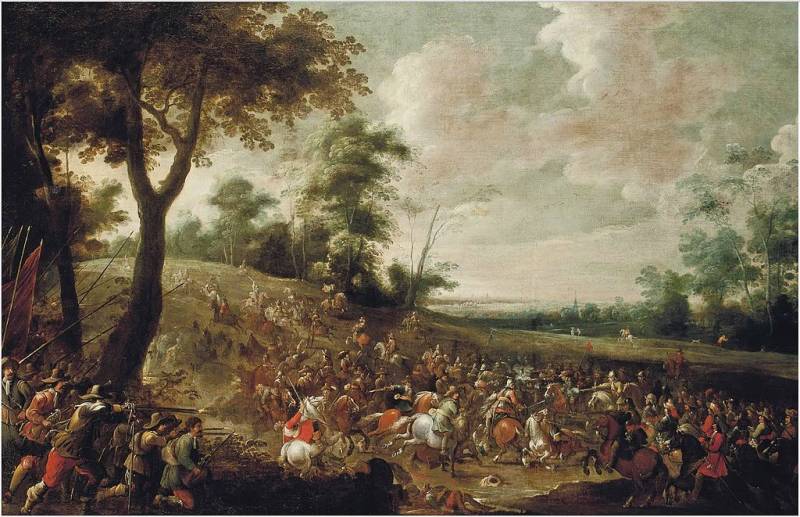
But this “Cavalry Attack” (Christie’s Auction 2013, London) of the same artist, written by him between 1625 and 1654, shows us the cavalry, which is supported by the musketeers hiding in the forest on their left
It is believed that the first Flemish battle painter was Sebastian Wranks (1573-1647), who was the first in the art of Northern Europe to turn battle scenes into a separate genre. However, why be surprised, because he was an officer of the civilian police of Antwerp and saw all this around him. And the fact that about half of Vranks's famous works are military scenes is quite logical. And by the way, it was him who studied the same Peter Möhlener and many other famous Flemish painters like Peter Paul Rubens, Jacob Jordaens, Hendrick van Balen, and Jan Brueghel the Elder (son of Peter Brueghel the Elder) often helped and often co-authored him individual paintings. He also raised several students, the best among whom were Frans Sneijders.
Wranks' paintings resemble Bruegelian paintings, especially those in which he depicted the life of modern-day Holland. But the battle canvases are again a wonderful illustrative material for the historian. Here, for example, his famous painting “The Battle of Lekkerbetier in Vuhta on February 5, 1600” which is in a private collection. First of all, let's find out what kind of battle it was that caused such an interest in this artist. In fact, it was ... a collective duel, held on February 5, 1600 on the wasteland between the city gallows (such a "living" trifle of the era) and the mill. The Flemings fought with the mercenaries - the French and the Brabants, in the amount of 22 people on each side, with typical weapons of the time. The instigators of the fight were the French aristocrat de Breuil and the Flemish lieutenant Lekkerbetier. Well, his main reason was the contempt of the French marquise for the Flemish nobles. By the way, the full name of the lieutenant was Gerard Abrahams van Hawlingen, and Lekkerbetier was his nickname, which meant both “bastard” and “vile” (in terms of origin). That is, the Flemings did not consider such shameful nicknames as offensive to their warriors, the main thing is that they fight well!
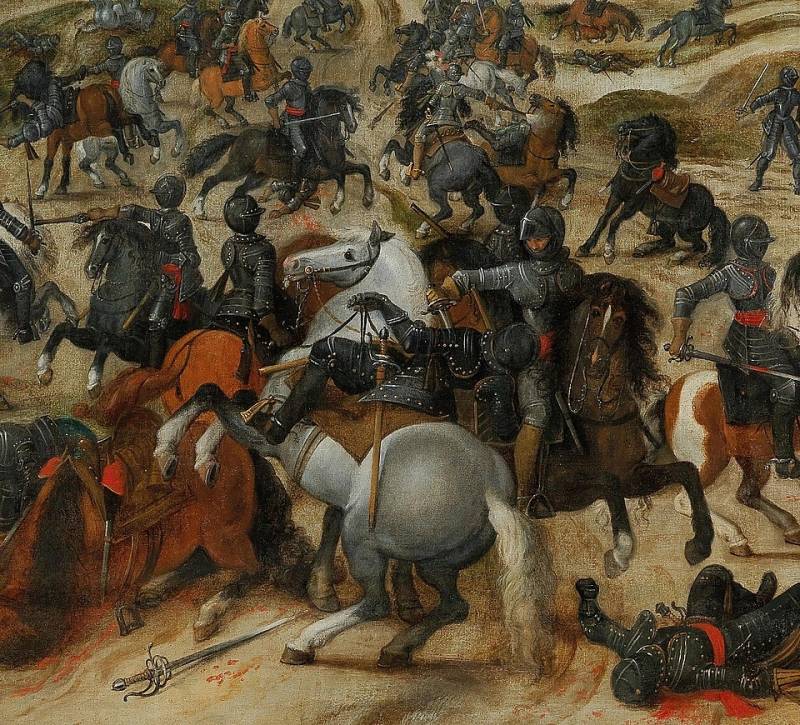
Detail of a close-up picture. All participants have black armor, that is, those riders who were called the “Black Kaftans”, and “Black Armor”, and “Black Devils”, “Black Gangs” and even simply “Curious” - in different countries . Cheap armor painted, expensive ink at high temperature. Their weight was from 12 kg and above (together with a helmet), but there were such super-armor that weighed 30 and even 46 kg
The center of the composition of the Wranks painting was Lekkerbetier and de Bre, dressed in typical armor-like armor, cuirassiers armor. According to storiesLekkerbetier was shot with a pistol at the very beginning of the duel, but despite this the Flemings won a complete victory, killing 19 Frenchmen. The Marquis de Breu fled from the battlefield, but was captured and also killed.
Vranks was a very diverse and versatile artist, as evidenced by his exceptionally multi-figured tightly written by him in collaboration with Jan Brueghel the Younger “Consequences of the Battle”, located in one of the private collections. And why, and who is not here. The captured banner and boots, muskets and hats scattered on the ground, the naked corpses of the dead, groaning wounded, they take off their boots and strip them to the skin, and they pin someone with a blow to the throat and back. There is also a knightly spear lying around (meaning the spearmen are still in use!) And plate “pipes” for hands, cuirasses and an iron shield of the ranger. In the distance they catch a white horse and escort a captive latnik, apparently a noble man, since they did not immediately kill him. In a word, all the attributes of the era, human characters and actions - everything is presented in full view. Visibly, figuratively and very clearly.
Some of his stories are pretty, let's say, amazing. For example, this refers to several canvases devoted to such narrow topics (and therefore not so narrow for that time, is it?), Like attacks on riders, armored men and infantrymen on a convoy, and robbers on peaceful travelers on a high road!
On this canvas, again, we see exclusively multifaceted action. On a plain that goes beyond the horizon, again with several gallows in the distance on a hill, a caravan moves along the road, and the front carts obviously tried to stand in a circle, but obviously did not have time, peaceful travelers, taking advantage of the bustle, women and children flee into the forest. The attack on the wagons is carried out in a complex manner: on the left, musketeers fire at him at close range, while pistols and carabinieri are the first to shoot from the side of the road, firing at the back ... spearmen with long knightly spears. Well, and on the hill to the right, the shepherd drives away from the sin a herd of sheep.
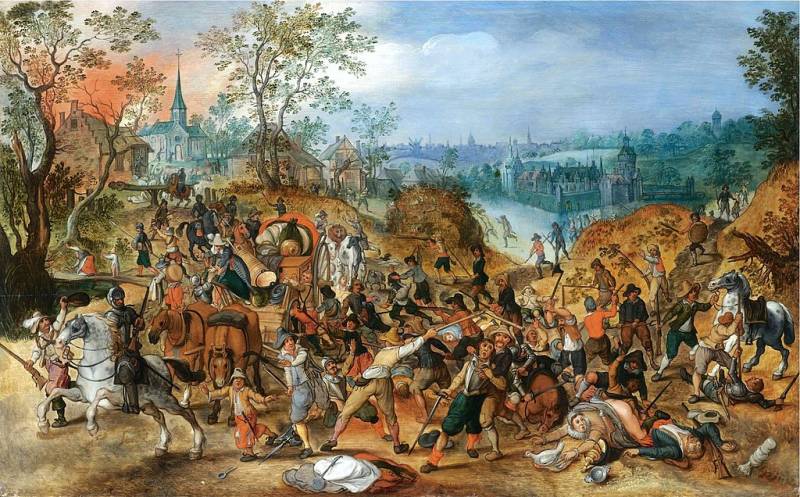
Another funny painting, written in the typical Bruegelian style of Wranks, is called: “A landscape with robbers who ambushed travelers outside the small town” (Sotheby's Auction, London 2008) We see on it that robbery on highways was a trade, in which many people participated, and armed not only with pitchforks, but also with firearms and attackers with such a mass that even armored men could not cope with them. One of them is running, the other is being chopped with an ax, the third is being stabbed with a pitchfork, someone is being beaten with an ordinary flail, and the lady traveler has already wrapped a skirt over her head ... well, how could it be without this - most likely that was
The most interesting thing is that this plot later became very widespread among the paintings of his students and followers. The truth of life, apparently, was just that.
By the way, it was Vranks who began to paint canvases depicting battles on the ground, paying great attention to the topographic accuracy of the depicted scene, and then this style was adopted and developed by another artist of the same era, Peter Snyers (1592-1667). He developed the technique of depicting his teacher, highlighting three planes on the canvas - front, middle and distant. The foreground is always a few basic figures, for example, the commander who oversees the battle. But here we can see the wounded, and alarmists, and deserters, and anyone else - even so. In the central part - the collision itself was depicted, but the last third of the picture is a landscape that turns into a distant calm sky. And although the artist himself did not participate in any of the battles, most of his Snyers paintings were official orders of the high command of the Habsburg army, which would not have happened if they had reproduced the pictures of the named battles inaccurately!
And it is not without reason that the Vienna Military History Museum has a whole “Piccolomini series” of 12 large-format canvases written by him between 1639 and 1651, which illustrates all the highlights of the campaigns of the famous imperial field marshal Ottavio Piccolomini, who fought in Lorraine and France in the last thirty years. war.
In this characteristic manner he wrote many canvases, but one of them is perhaps the most revealing in the sense of studying the tactical constructions of cavalry and infantry from the beginning of the 1605th century. This is the picture “The Battle of Kirholm” that took place in 1673. It is known about her that she was ordered for the Polish-Lithuanian king Sigismund III, through his agent at the Brussels court of Archduke Albert VII. Then it was brought to France and sold at auction in 1820. This work was first mentioned in the inventory of the castle of Sassenage in XNUMX, where it is to this day.
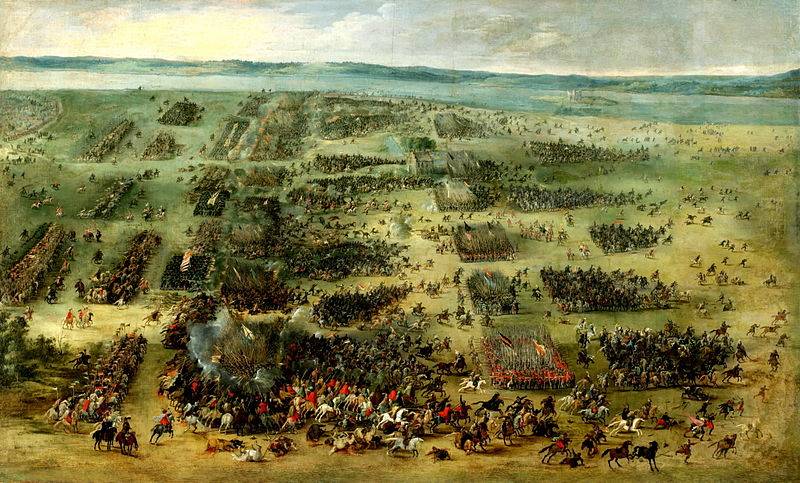
Here is the picture. You just need to look at it carefully to evaluate the work of the master. By the way, its height is 142 cm, and the length is 231,5 cm
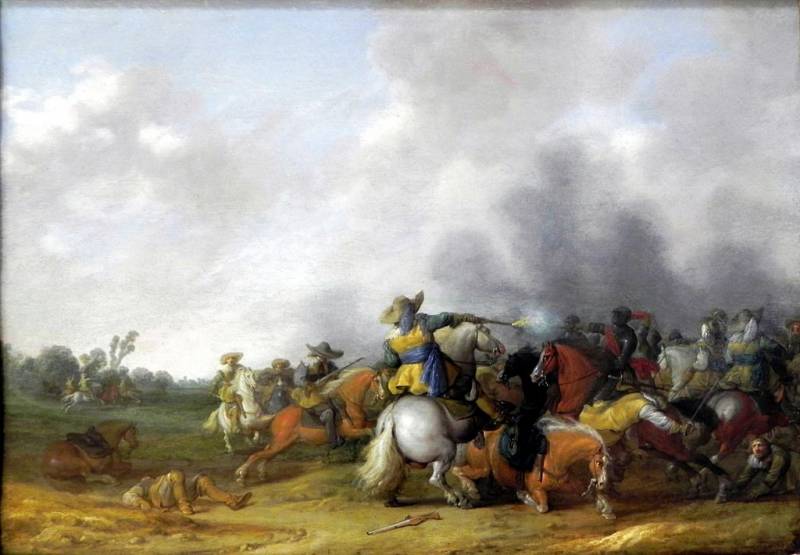
Palamedes Palamedes (1607-1638) - the younger brother of Anthony Palamedes, the author of many "guard", also painted the battles of riders of the Thirty Years War. One of his many paintings on this subject and with a traditional plot - these riders, scorching pistols at each other, was called: “The cavalry does its duty”, 1635. (German Historical Museum, Berlin)
We met (and this is the most important) only with a very insignificant part of the battle canvases depicting the battles of riders of the XNUMXth century, and the battle of the Thirty Years War, but in reality there are many times more. Samples of weapons, armor, ammunition, yellow leather caftans - all this is repeated by different artists in different variations, but the conclusion is the same: that was exactly then and we see something very close to modern photography on these canvases. Well, having glanced at the Dresden Armory, the Vienna Armory of the Hovburg Palace and the arsenal in Graz, you can also see that the painters painted this armor and weapons from nature.
To be continued ...
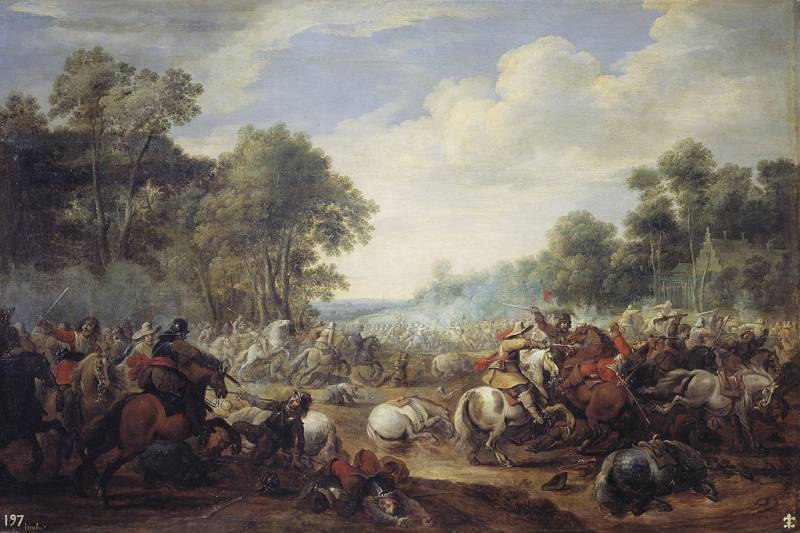
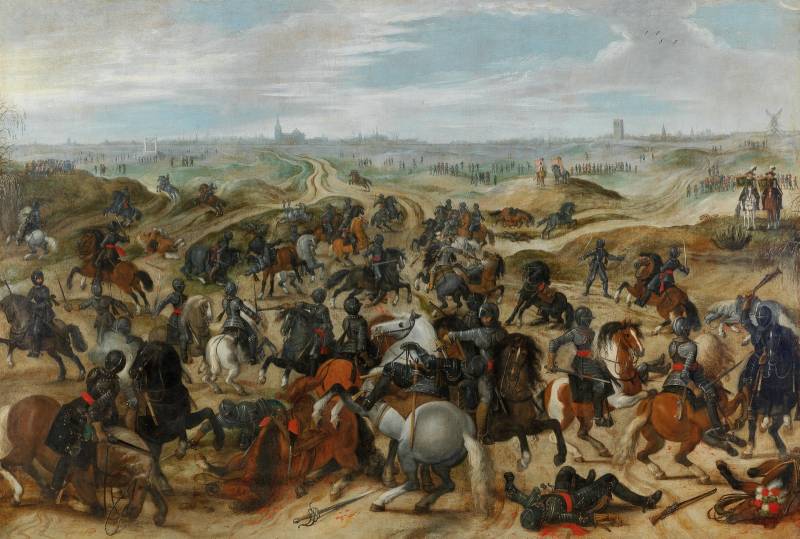
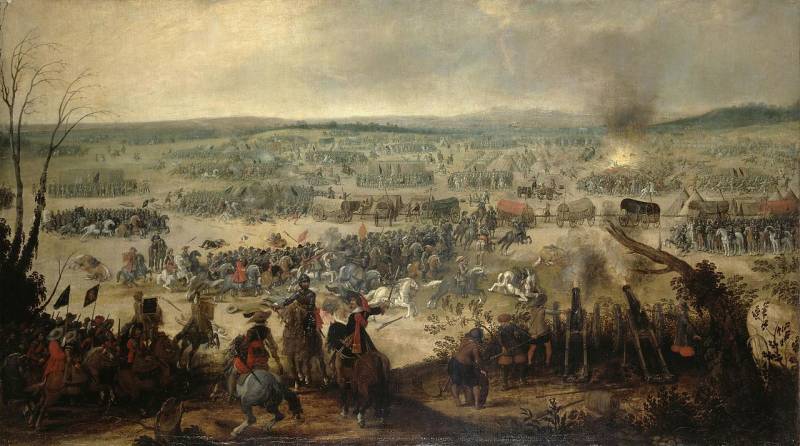
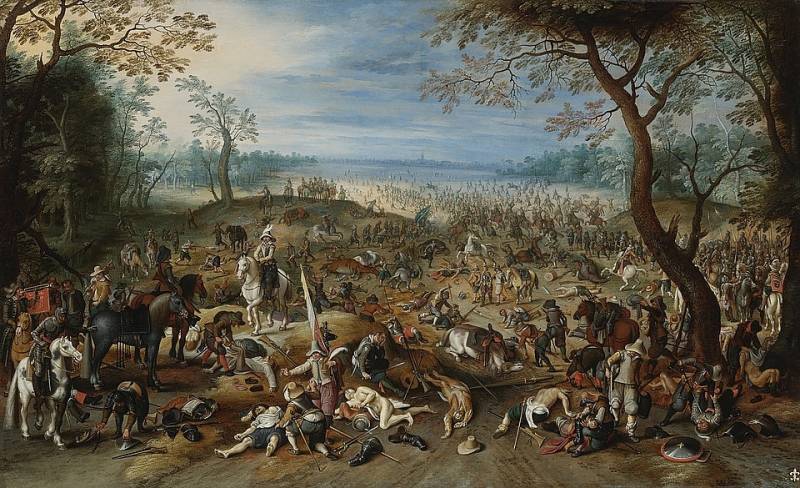
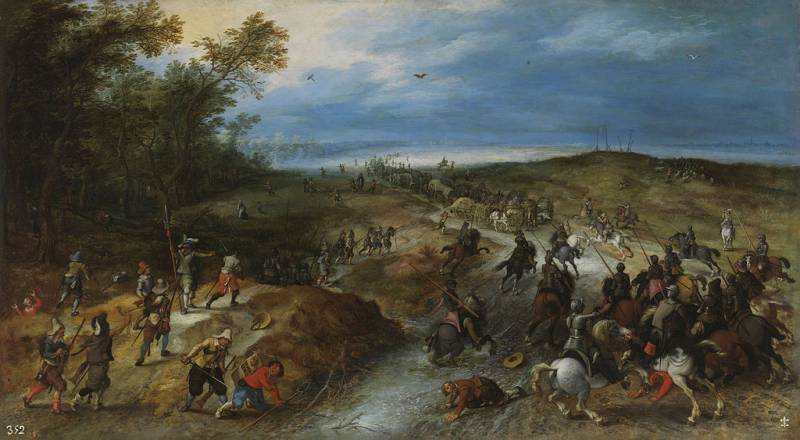
Information